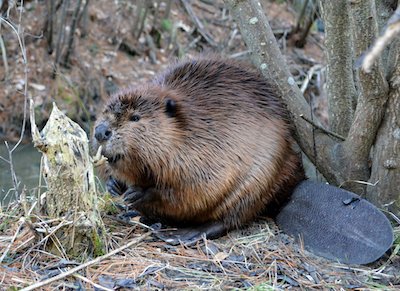Landscape Lenses
Ecological Landscape : Wildlife Habitat
It is common to assume that wildlife habitat is restricted to the forest or other wild place, and while it is true that most animals have adapted to specific natural environments, this does not mean that there is not good potential wildlife habitat right in the city limits of Burlington. An over grown back yard can be home to dozens of voles, and your porch eve may be a phoebe’s favorite nesting spot. As we learn to identify the resources that are important to wildlife, we see more clearly the relationship between the cultural and natural environment.

Open fields areas in the Intervale and Rock Point are also vital for wildlife, especially fallow or abandoned fields that have not yet re-forested. These fields are of particular importance to grassland birds, many of which are seeing population declines throughout Vermont. The loss of field habitat in the years since Vermont's agricultural peak back in the late 1800's has meant a decline in birds such as the bobolink and the eastern meadowlark. Agricultural fields also provide a home for many small rodents such as short-tailed shrews and meadow voles, which are important prey for owls, hawks, coyotes and many other species
Even the residential and business areas of Burlington offer habitat for many species, particularly the "generalists," those with a wider possible range of diet and habitat. Many of us have seen deer nibbling the tender shoots of our own or our neighbors' gardens. We've caught a quick glimpse of a fox darting across the road in the broad beam of the car headlights, and we've heard of raccoons getting into garbage cans that had been set out for early morning trash removal. We're also familiar with the backyard birds -- American robins, mourning doves, northern cardinals and many others.
As you explore Burlington, think like an animal. How are food, shelter and water connected? How do cultural features break up or enhance the habitat? It’s important to think of the landscape at the appropriate scales as well. For example, by the time a juvenile tree swallow reaches the end of its first summer it has explored all of the power line perches, shallow pools of water and wheat fields in its territory. It glides effortlessly over highways and rivers, and by early fall it is ready to leave its parent’s home territory and head south for the winter. A red-backed vole born in the same pasture as the swallow is not so lucky. As it grows to maturity and wanders further away from its natal territory, it will encounter many of the same landscape features as the swallow, but with more dire consequences. At worst it will not survive the dangerous four-lane highway, irrigation ditch, and mowed power line, at best it will be forced to share limited habitat and resources with its parents and siblings.
We could study the effects of development and fragmentation on every single organism on our community, but most wildlife biologists work with just a few focal species within an area. There are a few ways that information about just one species can tell you about many of the other animals in your community. Top predators such as bobcats are known as keystone species because they control the entire food chain below them, from deer and rabbits, to trees and herbs. Other species such as bears require large areas of high quality habitat. A decline in these populations often signals the early effects of fragmentation, while an increase could indicate a broad scale regeneration of habitat.
As you learn about the wildlife species, remember that with few exceptions, their welfare is intimately connected to your town’s development and conservation strategies. Some animals such as white tailed deer do very well in agricultural areas where there is abundant edge habitat and palatable vegetation. Others such as river otters, will only survive in a forested riparian habitat. Land use strategies dramatically impact animal populations, but look for other forms of human impact as well such as pollution or over (and under) harvesting of game species.